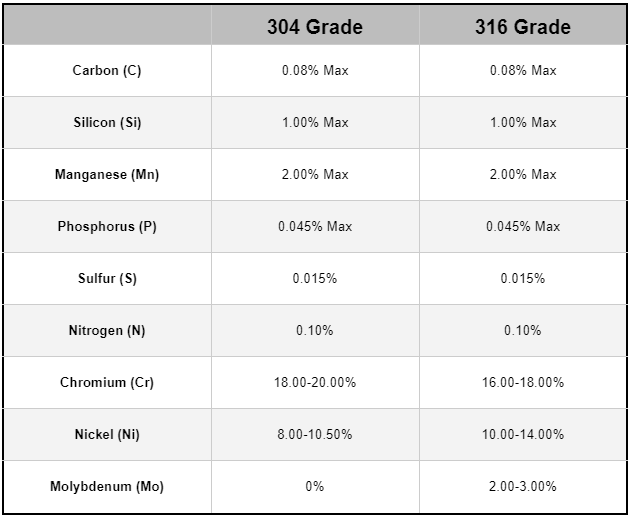Introduction to 300 Series Austenitic Stainless Steel
In the world of materials science, stainless steel has become a cornerstone of modern engineering, with the 300 series austenitic grades standing out for their exceptional combination of strength, flexibility, and corrosion resistance. These alloys are widely used in industries ranging from food processing to medical equipment due to their durability and aesthetic appeal. Among them, grades like 304 and 316 are particularly well-known for their high performance and versatility.

The Foundation of Stainless Steel: Chromium
Chromium is the key element that gives stainless steel its name and its defining property—corrosion resistance. When chromium is added to iron, it reacts with oxygen in the air to form a thin, protective oxide layer on the surface. This passive layer prevents further oxidation and protects the underlying metal from rust and degradation. Most stainless steels contain at least 10% chromium, making it the backbone of this remarkable material.
304 Stainless Steel: The Versatile Workhorse
Among the 300 series, 304 stainless steel is the most commonly used grade. It contains about 18% chromium and 8% nickel, which gives it excellent corrosion resistance and good mechanical properties. Its affordability and ease of fabrication make it ideal for a wide range of applications, including kitchenware, appliances, and architectural components. However, it is less suitable for environments with high chloride exposure, such as coastal areas or chemical processing plants.
316 Stainless Steel: The Corrosion-Resistant Champion
To improve corrosion resistance, especially in harsher conditions, 316 stainless steel adds molybdenum to the mix. With 16% chromium, 10% nickel, and 2% molybdenum, this grade is highly resistant to pitting and crevice corrosion, making it ideal for marine environments, chemical processing, and pharmaceutical applications. Its enhanced properties come at a slightly higher cost, but they are often justified by the demanding conditions it can withstand.
A Comparative Look: 304 vs 316 Stainless Steel
While both 304 and 316 are part of the 300 series, they serve different purposes. 304 is the go-to choice for general-purpose use where standard corrosion resistance is sufficient. In contrast, 316 is preferred in environments with high chloride content, such as seawater or industrial settings. Understanding the differences between these two grades helps in selecting the right material for the job.
Welding and Forming: The Common Strengths
One of the standout features of the 300 series is their excellent weldability and formability. Both 304 and 316 can be easily shaped into complex designs without losing their structural integrity. Unlike some other stainless steels, they cannot be hardened through heat treatment, but they can achieve high strength through cold working. For applications requiring welding and forging, low-carbon variants like 304L and 316L are often recommended, offering better weldability and corrosion resistance.
Typical Uses Across Diverse Industries
304 stainless steel is commonly found in kitchens, hospitals, and commercial buildings. Its ability to resist corrosion from everyday substances makes it a reliable choice for sinks, countertops, and ventilation systems. On the other hand, 316 is used in more extreme conditions, such as offshore oil rigs, chemical reactors, and medical devices, where exposure to saltwater or aggressive chemicals is common.
Both grades also find use in the construction industry, where their durability and aesthetic finish are highly valued. Whether it's for structural supports or decorative elements, 300 series stainless steels offer a balance of function and appearance that few other materials can match.
Super Austenitic Grades: Extending Performance
Beyond the standard 304 and 316 grades, there are super austenitic stainless steels designed for even more extreme environments. These high-nickel alloys provide superior resistance to corrosion and oxidation, making them ideal for applications in the chemical, aerospace, and nuclear industries. Their enhanced properties come with a higher price tag, but for critical applications, the investment is often worth it.
Compositions of Austenitic Stainless Steel
Frequently Asked Questions
1. What makes 304 and 316 stainless steel resistant to corrosion?
The main reason is the presence of chromium, which forms a protective oxide layer on the surface. Additionally, 316 contains molybdenum, which enhances its resistance to pitting and crevice corrosion, especially in chloride-rich environments.
2. How does the addition of molybdenum enhance the properties of 316 stainless steel?
Molybdenum improves the steel’s resistance to pitting and crevice corrosion, making it more durable in harsh environments like seawater or chemical processing facilities.
3. What are super austenitic grades, and how do they differ from 304 and 316?
Super austenitic grades have higher nickel content and improved corrosion resistance compared to standard 304 and 316. They are used in extreme conditions where regular grades might fail, such as in high-temperature or chemically aggressive environments.
Shop Stainless Steel Instrumentation Fittings
Shop Stainless Steel Cast 150# Fittings
Shop Stainless Steel Nipples
Shop Stainless Steel Forged 3000# Fittings
Shop Stainless Steel Flanges
Shop Stainless Steel Weld Fittings
Shop Stainless Steel Tubing
Complex Brass Tube,Copper Pipe Fittings,Protection Copper,Brass Sleeve
TAICANG CITY JINXN COPPER TUBE CO.,LTD , https://www.jinxincopperpipes.com
![<?echo $_SERVER['SERVER_NAME'];?>](/template/twentyseventeen/skin/images/header.jpg)